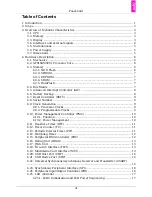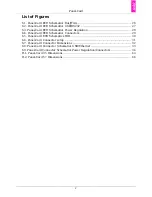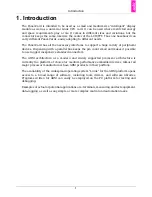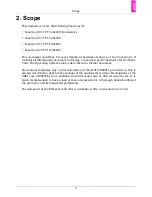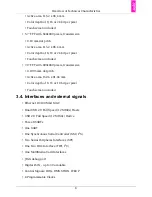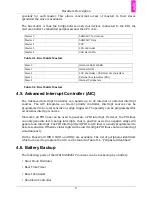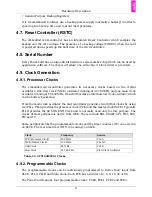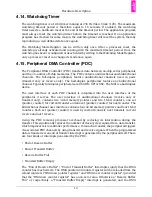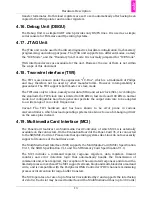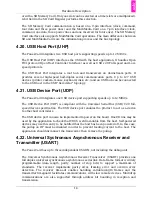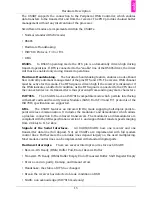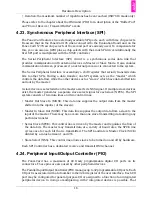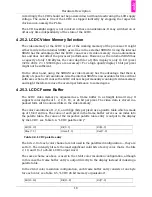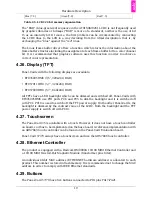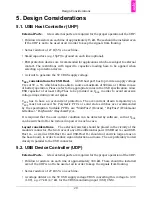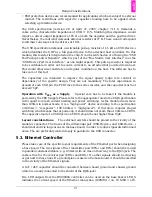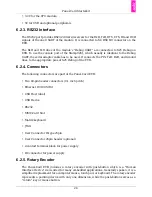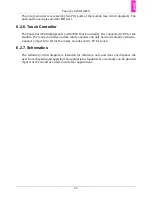
Hardware Description
11
•
Power-down Mode.
In many cases a system waits for a user action or some other
rare event. In such a case, it is possible to change MCK to SLCK. Any external event
which changes the state on peripheral pins (not the USB) can then be detected by the
PIO controller or the AIC.
It should also be taken into account that when a PLL is stopped it will take some time to
restart it. Changing the PLL frequencies or stopping them can therefore be done only
at a moderate rate. If short reaction times are required, this is not a choice.
Additionally further measurements can reduce power consumption considerably:
• switching off the TFT supply voltage
• putting peripheral chips like Ethernet controller and / or PHY or serial driver devices
in power down mode
• putting the SDRAM into self-refresh mode
4.11. Real-time Timer (RTT)
The Real-time Timer is a 32-bit counter combined with a 16-bit prescaler running at Slow
Clock (SLCK = 32768 Hz). As the RTT keeps running if only the backup supply voltage is
available, it is used as a Real-time clock.
The RTT can generate an interrupt every time the prescaler rolls over. Usually the RTT is
configured to generate an interrupt every second, so the prescaler will be programmed
with the value 7FFFh.
The RTT can also generate an alarm if a preprogrammed 32-bit value is reached by the
counter.
4.12. Timer Counter (TC)
The Panel-Card features one block of timer counters with three counters. None of them is
available on the connectors. You can only use them internally.
The TC consists of three independent 16-bit Timer/Counter units. They may be cascaded
to form a 32-bit or 48-bit timer/counter. The timers can run on the internal clock sources
MCK/2, MCK/8, MCK/32, MCK/128, SLCK or the output of another timer channel. External
clocks may be used as well as the counters can generate signals on timer events. They
also can be used to generate PWM signals.
4.13. Periodic Interval Timer (PIT)
The PIT consists of a 20-bit counter running on MCK / 16. This counter can be preloaded
with any value between 1 and 2
20
. The counter increments until the preloaded value is
reached. At this stage it rolls over and generates an interrupt. An additional 12-bit counter
counts the interrupts of the 20 bit counter.
The PIT is intended for use as the operating system’s scheduler interrupt.
Содержание Panel-Card
Страница 1: ...Panel Card Technical Reference ...
Страница 32: ...Panel Card Starterkit 26 Figure 6 1 Panel Card EVB Schematics Bus JTAG ...
Страница 33: ...Panel Card Starterkit 27 Figure 6 2 Panel Card EVB Schematics USB RS232 ...
Страница 34: ...Panel Card Starterkit 28 Figure 6 3 Panel Card EVB Schematics Power Regulation ...
Страница 35: ...Panel Card Starterkit 29 Figure 6 4 Panel Card EVB Schematics Connectors ...
Страница 36: ...Panel Card Starterkit 30 Figure 6 5 Panel Card EVB Schematics HID ...
Страница 39: ...Panel Card Starterkit 33 Figure 6 8 Panel Card Connector Schematics USB Ethernet ...
Страница 40: ...Panel Card Starterkit 34 Figure 6 9 Panel Card Connector Schematics Power Regulation Connectors ...
Страница 49: ...Panel Card Dimensions 43 Appendix H Panel Card Dimensions Figure H 1 Panel Card 35 Dimensions ...
Страница 50: ...Panel Card Dimensions 44 Figure H 2 Panel Card 57 Dimensions ...

